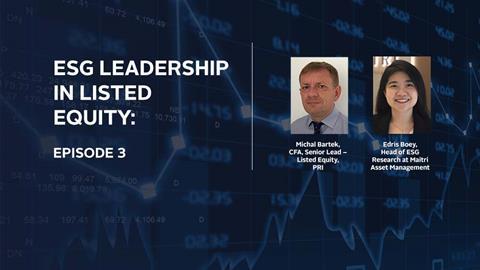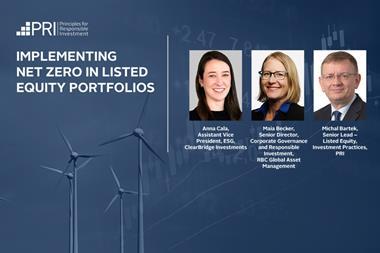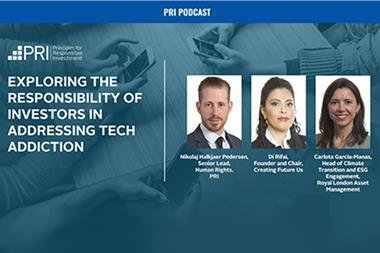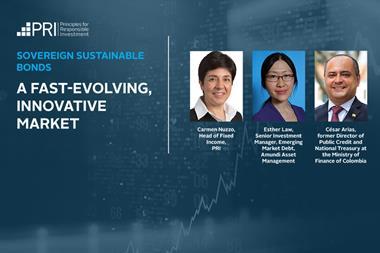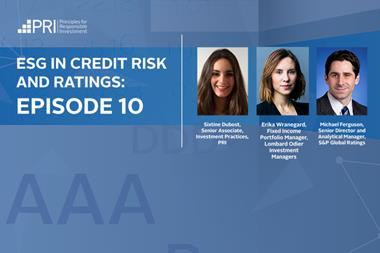ESG leadership in listed equity episode 3
With Michal Bartek, CFA, Senior lead – Listed equity, PRI and Edris Boey, head of ESG research at Maitri asset management
Michal Bartek
Welcome to the PRI podcast. In this episode on listed equities, we will talk to Edris Boey, Head of ESG research at Maitri Asset Management - Singapore based multifamily office. With more than a decade of experience in the sustainability consulting reporting and investing space, she’s in a good position to share her observations on the evolution of ESG investing on notable developments and expectations of the future.
This podcast is part of a series on listed equity in which we explore wide range of topics. My name is Michal Bartek and I work as senior lead in equities investment practices team that develops content for signatories to help them integrate ESG into their investment process.
So Edris, you have been involved with sustainability and ESG for longer than most of your peers in the Asia Pacific region. What has from your personal experience been most notable or surprising development?
Edris Boey
Hi, Michael, it’s a pleasure to be here. I’ve been a sustainability professional in Singapore for more than a decade and have observed the ESG space grow faster in the last 12 months than in the last 10 years I’ve been practicing. In my opinion, the pandemic has actually ensued this trend because of the sectors, which lacked investments as exposed by the pandemic. This is especially seen in the health care sector. It seems like there has been a pandemic realisation that investment decisions made in the past did not prioritise certain sectors that could have helped establish strong social fabrics. So the consequences of this have been laid for all to feel. Investors especially solve and institutional investors. They recognise now that there is a big room for improvement in terms of the criteria used in making investment decisions, that there is a need to more effectively consider risk holistically.
So to that end, looking at ESG issues is a very good to address these gaps. The boom in ESG investing now demonstrates that there are many ways to address ESG issues and there isn’t a one size fits all method. So, each investor will need to figure out how they want to apply ESG criteria into their own investment decisions. And this could exclude sectors, which are not aligned with their values such as traditional sin sectors like alcohol or gambling, or they could only invest in themes. They like such as, healthcare or clean tech, or they could also choose to be sector agnostic but only invest in sustainability leaders or companies who can demonstrate positive impact.
Michal Bartek
Do you believe there are any other drivers behind the faster pace of ESG adoption acceleration?
Edris Boey
As someone working in a multifamily office, I am also seeing the search in ESG investing from high network families. As they expedite their next gen members to take up decision making roles in the family, businesses and investments. APAC has the highest number of billionaires now, and it also happens to be where billionaires and ultra-high networks individuals are being mentored the fastest globally. This means that there is plenty of new wealth in APAC and the wealth creators could be in their sixties or seventies already. This group of people are still holding onto decision making power thinking. They could easily take their time to ease their next gens into stepping up. But with the uncertainty of surviving the pandemic, they are increasingly exposing their next gens into the foreground. And it is this next gen who are more in “woke” towards environmental and social issues such as climate change or sustainability performance of the family business operations. So, the next gen, they are instilling ESG considerations into their business and investment criteria. So, summing up, the two factors is that pre pandemic our investment decision making criteria tend not to be comprehensive enough and time horizon was too short. Long-termism is now becoming key and overlaying ESG considerations on top of financial analysis helps evaluate issues that could affect an investment over a longer time horizon.
Michal Bartek
Thank you very much for that. I’d just like to turn our attention now to the idea of leadership in listed equities. And so I would like to ask what, what advice, or what tips would you give to asset managers who wish to be up there with the leaders in this field?
Edris Boey
I think it is very important to surround yourself in the company of people you want to be like and to do so for ESG investing, it is to be plugged into the ESG networks where such leaders can be found. Being plugged into to such networks, firstly helps you get educated on a topic. Secondly, it helps get you into discussion or working groups. It serves as a platform for sharing and exchanging experiences. Thirdly, during the development and implementation phase of an ESG strategy, for instance, the platform can act as a sounding board especially when, when we meet with problems. So, within a single network, such as the PRI, you could be exposed to many different ESG investing frameworks and techniques, ESG data providers, as well as context to ESG specialists within other asset owners or other asset managers.
The PRI also includes opportunities to collaborate directly with leaders, such as through engagement initiatives, as you pick up experiences through the sharings of the investors who are actually leading the initiative. One more thing is that the PRI did play a very significant role in Maitri’s responsible investment education process. It was very important for us to review the best-case practices that the PRI published. It also helped us to identify other practitioners in Singapore to touch base with face to face. And there is a difference between just downloading the reports and reading it versus being a signatory and being part of the PRI, because internally signing up to the PRI is a commitment to report and disclose on our responsible investment practices annually. This makes the management more serious about adopting the principles. Externally, we are recognised as someone who is on the responsible investment journey and the network members are more willing to share because they are also motivated by the opportunity to be an advocate for responsible investing.
Michal Bartek
Thank you. So, you’ve explained the benefits for your organisation of being part of an investor or asset owner network. And you’ve provided us with an example of such engagement with peers, learning opportunities, the knowledge sharing and so on. But you did that in the context of Maitri’s position as a signatory of the PRI. And I think our audience may want to know whether there are any other entities or networks that you personally, or your organisation has been part of, you know, networks that have enabled you to be up there with the leaders in the responsible investing space, enlisted equities and beyond.
Edris Boey
Yes, certainly beyond the PRI another investor network that Maitri has found plenty of value from is, is the various regional investor networks on climate change. Maitri is Singapore based so, we sign up to the Asian investor group on climate change, or a AIGCC in short. Among other objectives, the network helps develop the net zero benchmarks and frameworks specific to investors. Maitri is a active member of the AIGCC and given that the industry’s evolving very quickly being part of various AIGCC working groups has helped Maitri to be at the forefront of climate change trends as we were involved in the development of some of these frameworks. This actually gives us more time to internalise market trends and think about how we want to implement them. For instance, our early participation has allowed Maitri to be only one of two Asian managers who have committed and disclosed, 2030 interim target under the Net Zero Asset Managers Initiative (NZAMI) in November, 2021.
Michal Bartek
I would like to turn our attention now to engagement - engagement with investee companies. Do you use your all or rely on engagement with investee companies? And if, if you do, are there any regional or cultural aspects to engagement that make it perhaps different from engagement with investee companies in other parts of the world, you know, Europe, North America?
Edris Boey
Yes. I think you’ve certainly hit the nail on the head. Engagement is increasingly a more meaningful tool for investors to use as compared to divestment when it comes to escalation on ESG issues. For instance, if we were to look at the climate change issue, the Paris aligned investment initiatives, net zero investment framework tells investors that divestment should actually be the last resort. And engagement of investing companies to develop net zero targets is the main focus of the whole framework. A side benefit on the push for global climate agenda is that corporations are now more attuned to investors engaging that on climate change issues, and they are more prepared and willing to engage on this. So, during such an engagement, actually other ESG issues can also be brought up. One more thing about engagement is that, you rightly put it that there is a difference in cultures and it plays a significant role on the effectiveness of an engagement.
It is obvious that the developed world is ahead of developing countries in terms of sustainability practices and hence the progress as well as expectations on the performance will be different depending where the company or the investors are from. In our experience, companies in Asia, tend to respond to investors who they believe will be able to understand that they’re still on the early stages of sustainability performance or journey. These investors can then, you know, take the opportunity to build a long term relationship with the company’s management in a constructive yet progressive tone. One example, that Maitri is engaged in is part of the AIGCC’s Asian electric utilities engagement program. The program targets five Asian electric utilities, which are not included in the Climate Action 100+ engagement list. Yet, these companies are high emitting and privately owned entities. So that’s a sweet spot we’ve found for our, the engagement is led by Asian investors. The conversations have been constructive and conducive. It is taking a bit of time to achieve concrete progress across all the companies uniformly. But we have received feedback from the investee companies that our engagement helps because the management and the investor relations department are able to bring back our feedback to the boards who will then be more encouraged to make more emission reduction plans to bring it forward if not to prioritise them.
Michal Bartek
So Edris you earlier mentioned, you know, what it takes to be a leader in responsible investing in the Asia Pacific region. You mentioned the benefits of being part of, you know, networks when it comes to learning and exchanging ideas and best practices. We often hear that it’s also important to be able to develop enough experienced staff. So how would you describe the situation in terms of your region, in terms of how easy or difficult it is to secure and nurture talent?
Edris Boey
Yes, Michael, that’s another great point that you have brought up, the talent pool isn’t something that can be developed overnight, in part due to the lack of education and career opportunities. The talent pool of sustainability professionals in Singapore has been limited. Given that the Western world, especially Europe is quite ahead of any market in terms of sustainability practices, Singapore, at least where I’ve been practicing for the past 10 years, I have observed that most of the sustainability expertise actually comes from their parent companies overseas. And the thing is there has been a change in the last 12 months, one critical development in Singapore is the monetary authority year of Singapore developing a green finance action plan. It has four main pillars and one key pillar is to build knowledge and capabilities in sustainable finance.
So this actually includes having local and overseas tertiary universities tie ups to groom a pipeline of talents in sustainability, as well as green finance. At Maitri, we also have a rolling ESG internship program where at any one point in time, we have an intern with us for a period of 10 to 20 weeks. They are from one of the three local universities, which has either, uh, an environmental school or a sustainability major. We bring the interns in and they do real ESG analysis, or they could be doing a research on an ESG theme or topic or could be doing due diligence on companies or sectors.
Michal Bartek
Thank you very much Edris for your experiences and sharing your observations and suggestions. If you enjoyed this episode, then please do subscribe and rate our podcast, then tune in to the next one. Thank you.
Downloads
Transcript: ESG leadership in listed equity episode 3
PDF, Size 0.21 mb


